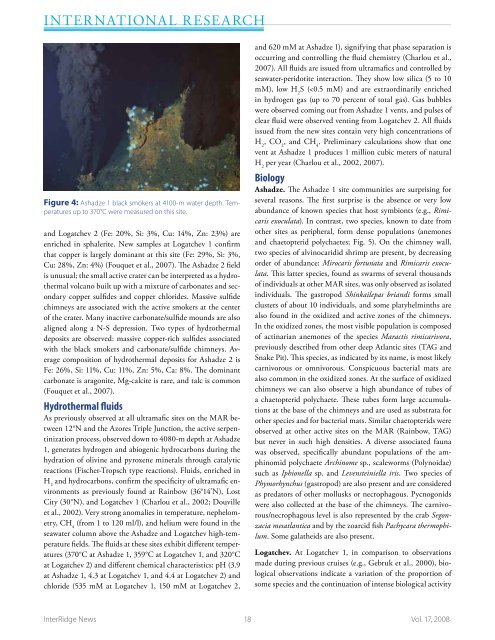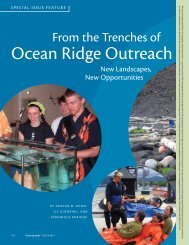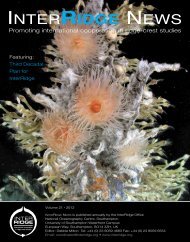International Research Figure 4: Ashadze 1 black smokers at 4100-m water depth. Temperatures up to 370°C were measured on this site. and Logatchev 2 (Fe: 20%, Si: 3%, Cu: 14%, Zn: 23%) are enriched in sphalerite. New samples at Logatchev 1 confirm that copper is largely dominant at this site (Fe: 29%, Si: 3%, Cu: 28%, Zn: 4%) (Fouquet et al., 2007). The Ashadze 2 field is unusual; the small active crater can be interpreted as a hydrothermal volcano built up with a mixture of carbonates and secondary copper sulfides and copper chlorides. Massive sulfide chimneys are associated with the active smokers at the center of the crater. Many inactive carbonate/sulfide mounds are also aligned along a N-S depression. Two types of hydrothermal deposits are observed: massive copper-rich sulfides associated with the black smokers and carbonate/sulfide chimneys. Average composition of hydrothermal deposits for Ashadze 2 is Fe: 26%, Si: 11%, Cu: 11%, Zn: 5%, Ca: 8%. The dominant carbonate is aragonite, Mg-calcite is rare, and talc is common (Fouquet et al., 2007). Hydrothermal fluids As previously observed at all ultramafic sites on the MAR between 12°N and the Azores Triple Junction, the active serpentinization process, observed down to 4080-m depth at Ashadze 1, generates hydrogen and abiogenic hydrocarbons during the hydration of olivine and pyroxene minerals through catalytic reactions (Fischer-Tropsch type reactions). Fluids, enriched in H 2 and hydrocarbons, confirm the specificity of ultramafic environments as previously found at Rainbow (36°14’N), Lost City (30°N), and Logatchev 1 (Charlou et al., 2002; Douville et al., 2002). Very strong anomalies in temperature, nephelometry, CH 4 (from 1 to 120 ml/l), and helium were found in the seawater column above the Ashadze and Logatchev high-temperature fields. The fluids at these sites exhibit different temperatures (370°C at Ashadze 1, 359°C at Logatchev 1, and 320°C at Logatchev 2) and different chemical characteristics: pH (3.9 at Ashadze 1, 4.3 at Logatchev 1, and 4.4 at Logatchev 2) and chloride (535 mM at Logatchev 1, 150 mM at Logatchev 2, and 620 mM at Ashadze 1), signifying that phase separation is occurring and controlling the fluid chemistry (Charlou et al., 2007). All fluids are issued from ultramafics and controlled by seawater-peridotite interaction. They show low silica (5 to 10 mM), low H 2 S (
International Research Figure 5: Ashadze 1 populations of Maractis rimicarivora. on the Irina 2 area. However, the vesicomyid clams, emblematic of this area, have disappeared. The finding of extensive dead mussel fields on Logatchev 2 is surprising. The shells are intact, recent, and seem to indicate a catastrophic event that rapidly destroyed the environment favourable to the growth of mussels. A few live mussels and large populations of shrimp were however observed on the active chimney. Krasnov. From a biological point of view, few fauna were observed; only a few bacterial mats covering several tens of square meters were observed at the bottom of the cliff splitting the sulfide mound. Cruise website http://www.ifremer.fr/serpentine Acknowledgements We thank the crew of R/V Pourquoi pas? and ROV Victor for their constant technical effort to make the Serpentine cruise a success. We warmly thank Dr. Ivanov, Dr. Beltenev, and the scientific group of the R/V Professor Logatchev for exchange of information before and during the cruise when we met at the Ashadze 2 field. We also thank D. Smith for making available regional multibeam maps for the Ashadze area. References Batuev, B.N., Krotov, A.G., Markov, V.F., et al., Massive sulfide deposits discovered and sampled at 14°45’N, Mid-Atlantic Ridge, BRIDGE Newsletter, 6, 6-10, 1994. Beltenev, V., Nescheretov, A., Shilov, V., et al., New discoveries at 12°58'N, 44°52'W, MAR: Professor Logatchev-22 cruise, initial results. <strong>InterRidge</strong> News, 12, 13-14, 2003. Beltenev. V., Shagin. A., Markov V., et al., A new hydrothermal field at 16°38’N, 46°28.5’W on the Mid-Atlantic Ridge. <strong>InterRidge</strong> News, 13, 2004. Cannat, M., Ondréas, H., Fouquet, Y., et al., Geological context of ultramafic-hosted hydrothermal vent fields in the 13- 15°N region of the Mid-Atlantic Ridge: preliminary results of the Serpentine cruise. AGU Fall Meeting, EOS, 88, 52, 2007. Charlou, J.L., Donval, J.P., Konn, C., et al., High hydrogen and abiotic hydrocarbons from new ultramafic hydrothermal sites between 12°N and 15°N on the Mid-Atlantic Ridge. Results of the Serpentine cruise (March 2007). AGU Fall Meeting, EOS, 88, 52, 2007. Charlou, J.-L., J.P. Donval, Y. Fouquet, et al., Geochemistry of high H 2 and CH 4 vent fluids issuing from ultramafic rocks at the Rainbow hydrothermal field (36°14’N, MAR). Chemical Geology, 191, 345-359, 2002. Cherkashov, G.A., Ashadze, A.M., and Gebruk, A.V., New fields with manifestations of hydrothermal activity in the Logatchev area (14°N, Mid-Atlantic Ridge). <strong>InterRidge</strong> News, 9, 26-27, 2000. Douville, E., J.-L. Charlou, E.H. Oelkers, et al., The Rainbow vent fluids (36°14’N, MAR): the influence of ultramafic rocks and phase separation on trace metal content in Mid- Atlantic Ridge hydrothermal fluids. Chemical Geology, 184, 37-48, 2002. Fouquet Y., Cherkashov G., Charlou J.L., et al., Diversity of ultramafic hosted hydrothermal deposits on the Mid Atlantic Ridge: first submersible studies on Ashadze, Logatchev 2 and Krasnov vent fields during the Serpentine cruise. AGU Fall Meeting, EOS, 88, 52, 2007. Gebruk, A.V., P. Chevaldonné, T. Shank, et al., Deep-sea hydrothermal vent communities of the Logatchev area (14°45’N, Mid-Atlantic Ridge): Diverse biotopes and high biomass. Journal of the Marine Biological Association UK, 80, 383-393, 2000. Krasnov, S.G., G.A. Cherkashov, T.V. Stepanova, et al., Detailed geological studies of hydrothermal fields in the North Atlantic, in Parson, L.M., Walker, C.L., and Dixon, D.R., eds., Hydrothermal Vents and Processes: London, Geological Society Special Publication, 87, 43-64, 1995. Ondréas, H., Cannat, M., Cherkashov, G., et al., High <strong>resolution</strong> mapping of the Ashadze and Logatchev hydrothermal fields, Mid-Atlantic Ridge 13-15°N. AGU Fall Meeting, EOS, 88, 52, 2007. Sudarikov, S., Davydov, M., Cherkashov, G., et al., A new hydrothermal plume at 12°54.6'N Mid-Atlantic Ridge; initial results of the R/V Yuzhmorgeologiya cruise. <strong>InterRidge</strong> News, 10, 37-40, 2001. For an extended <strong>version</strong> of this article by Fouquet et al., please download the PDF from the online supplement to this year’s <strong>InterRidge</strong> News at: www.interridge.org/IRNewsletter. <strong>InterRidge</strong> News 19 Vol. 17, 2008
















